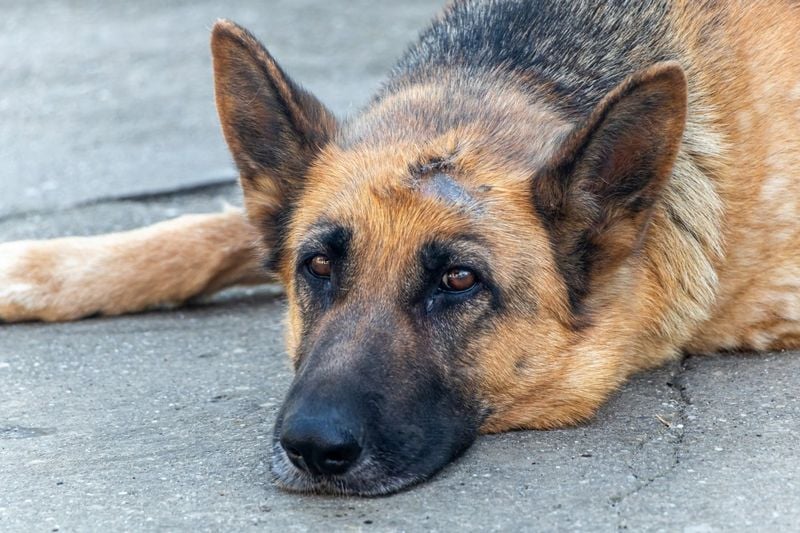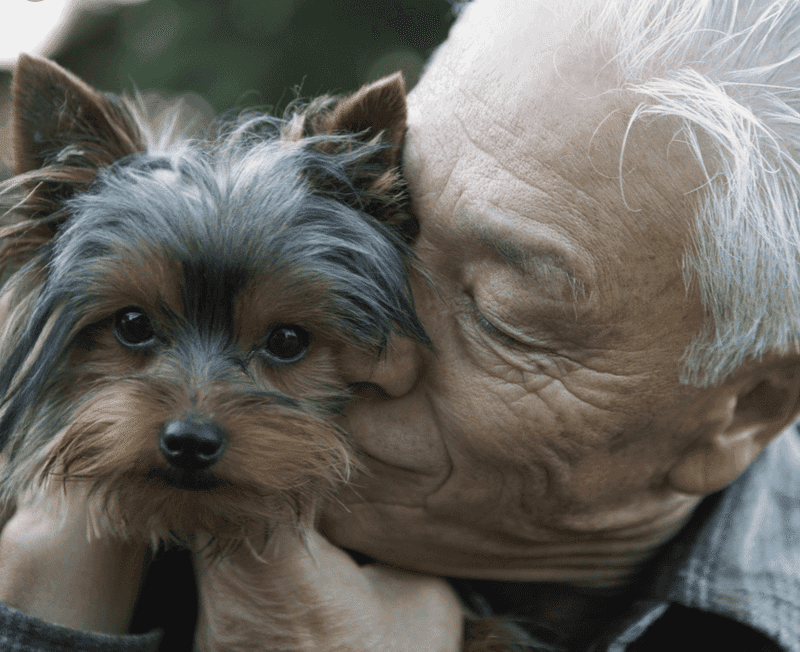16 Heartbreaking Ways Dogs Mourn the Death of Their Owners
When a beloved owner passes away, dogs experience profound grief that manifests in behaviors eerily similar to human mourning. These loyal companions form deep emotional bonds with their humans and can sense when someone they love is gone forever. Understanding how dogs express their grief not only helps us support them through their loss but also reminds us of the remarkable emotional depth these animals possess.
Dogs may not understand death in the same way humans do, but they keenly feel the absence of someone who was central to their world. From refusing to eat to pacing through empty rooms, dogs exhibit signs of confusion, anxiety, and sorrow that are unmistakable.
Some may search tirelessly for their lost human, while others withdraw, seemingly overwhelmed by a sadness they can’t articulate. These behaviors aren’t just coincidental—they are genuine expressions of mourning rooted in the deep connection they shared.
Just as people cope with grief in different ways, so too do dogs. Some seek constant comfort, clinging to other family members for support. Others turn inward, avoiding affection and retreating to quiet corners of the house.
Recognizing these signs can be crucial in helping a grieving pet heal, and it underscores a truth many pet owners already know: dogs are emotional, sentient beings capable of feeling tremendous love—and tremendous loss.
Here are 16 common and often heartbreaking ways dogs grieve when their owner passes away.
1. Loss of Appetite
Many grieving dogs completely lose interest in food, sometimes refusing to eat for days. Their emotional distress overwhelms their basic survival instincts, making mealtime meaningless without their special person there.
Veterinarians often note that this appetite suppression stems from genuine depression rather than simple stubbornness. The smell of food that once brought excitement now fails to trigger any response.
Eventually, most dogs will resume eating, though some require gentle coaxing with special treats or hand-feeding to overcome this painful phase of mourning.
2. Lethargy and Fatigue
Dogs experiencing grief often display unusual tiredness, spending hours lying in one spot with little movement. Their once boundless energy vanishes, replaced by a heaviness that seems to weigh down their very spirit.
Morning walks that used to trigger excitement become difficult to initiate. Even young, typically energetic dogs might suddenly appear elderly in their movements and responsiveness.
This physical manifestation of emotional pain typically lasts several weeks, gradually lifting as they adjust to their new reality without their beloved human companion.
3. Searching for the Owner
After an owner dies, many dogs embark on heartbreaking searches throughout the home. They’ll check all familiar spots – bedrooms, favorite chairs, or places where daily routines occurred – with increasing desperation.
Some dogs pace from room to room, sniffing doorways and personal belongings. Others will wait by doors or windows for hours, expecting their person’s return at any moment.
This searching behavior can continue for months, with the dog gradually checking less frequently but still occasionally looking up hopefully when hearing sounds similar to their departed owner’s footsteps or voice.
4. Excessive Whining or Howling
Vocal expressions of grief often emerge as mournful howls or persistent whining that sound distinctly different from normal barking. These sounds carry a haunting quality that many caretakers describe as expressing pure heartache.
Nighttime typically brings increased vocalization, with some dogs howling at specific times when routines with their owner would normally occur. The sounds often seem directed at calling their person back home.
This vocal mourning frequently happens near items carrying the owner’s scent or in locations strongly associated with them, as if the dog is communicating directly with their departed human.
5. Pacing and Restlessness
Grieving dogs often display an inability to settle, moving constantly from room to room with visible anxiety. Their movements appear purposeless yet urgent, as if searching for something they can’t quite remember.
Sleep becomes elusive, with brief dozing interrupted by sudden alertness and renewed pacing. This restlessness frequently worsens at night or during times when interaction with their owner would normally occur.
The behavior stems from genuine distress and confusion about the disruption to their world. Most dogs gradually calm over weeks or months as they adjust to new routines and form attachments with remaining family members.
6. Clinginess to New Caregivers
Following their owner’s passing, many dogs develop intense attachment to whoever steps in as their new caregiver. This clingy behavior manifests as shadowing the person everywhere, even to the bathroom, with visible panic if separated.
Physical contact becomes essential for these grieving pets, who might press against legs or demand constant petting. The behavior stems from fear of losing another important figure in their lives.
While sometimes exhausting for caregivers, this attachment represents the dog’s attempt to establish new security in a world suddenly turned upside down. Patience during this phase helps dogs gradually develop healthier attachment patterns.
7. Withdrawal and Isolation
Some dogs respond to grief by retreating physically and emotionally from family members and activities. They might choose obscure corners of the house or hide under furniture, avoiding interaction entirely.
This withdrawal represents a profound depression rather than simple preference for solitude. Their eyes often appear vacant, lacking the spark of recognition or interest that normally defines their personality.
Gentle encouragement rather than forced interaction works best during this phase. Most dogs gradually emerge from isolation as their grief processes, though some may permanently maintain a more reserved personality than before their loss.
8. Changes in Sleep Patterns
Grief disrupts canine sleep cycles dramatically, with some dogs sleeping excessively while others develop insomnia. The quality of sleep often deteriorates, with twitching, whimpering, and apparent nightmares increasing.
Many grieving dogs abandon their regular sleeping spots, either avoiding beds associated with their owner or conversely refusing to leave them. Some create new sleeping arrangements that make little sense to humans but provide comfort to the dog.
These disruptions typically resolve gradually as the dog processes grief, though creating consistent bedtime routines helps speed recovery and provides security during this difficult transition period.
9. Destructive Behavior
Grief sometimes manifests as sudden destructive tendencies in previously well-behaved dogs. They might shred furniture, dig through carpets, or destroy personal items belonging to their deceased owner.
This behavior isn’t spite or poor training but rather an expression of overwhelming anxiety and confusion. The destruction often focuses specifically on items carrying their owner’s scent, suggesting an attempt to process their absence.
Providing appropriate outlets for this energy through extra exercise and puzzle toys helps reduce destructive episodes. Most dogs gradually return to normal behavior as they adjust to their loss and establish new routines.
10. Lack of Interest in Favorite Activities
The joyful dog who once raced for toys or leaped at the chance for walks might suddenly show complete indifference to these activities. Tennis balls lie untouched, and favorite games no longer spark any enthusiasm.
This apathy extends beyond physical activities to social interactions. Dogs who loved meeting neighbors or playing with canine friends may turn away or show minimal engagement when presented with these once-exciting opportunities.
The behavior reflects genuine depression rather than stubbornness. Gradually reintroducing brief, positive experiences helps most dogs rediscover joy, though some never regain the same level of enthusiasm they once showed.
11. Scent-driven Comfort
Many grieving dogs seek items saturated with their owner’s scent, sometimes collecting clothing, pillowcases, or shoes in special piles. They might sleep exclusively on these items or carry them from room to room for comfort.
The behavior showcases the powerful role scent plays in canine emotional processing. Dogs experience their world primarily through smell, and these scented items provide a tangible connection to their missing person.
While well-meaning people might remove these items thinking they prolong grief, allowing access to them actually provides important comfort. The dog will typically abandon these items naturally as their grief resolves and scents fade.
12. Overgrooming or Licking
Anxiety-driven behaviors like excessive licking of paws or flanks frequently emerge during canine grief. Some dogs develop bald spots or skin irritation from this constant self-soothing attempt.
This behavior represents the dog’s effort to manage overwhelming emotions through repetitive action. The rhythmic licking releases endorphins that temporarily calm their distress, similar to how humans might bite nails when anxious.
Early intervention prevents this coping mechanism from becoming a permanent habit. Providing alternative comfort through gentle massage, appropriate chew toys, and calming routines helps reduce overgrooming while the dog processes their loss.
13. House Soiling or Regressive Behavior
Even fully trained dogs may suddenly forget housebreaking rules after losing their owner. This regression isn’t defiance but rather emotional distress disrupting their normal functioning.
Beyond bathroom accidents, many dogs display other childlike behaviors – chewing inappropriate items, forgetting basic commands, or acting as if never trained. This regression represents genuine confusion and anxiety rather than deliberate misbehavior.
Responding with patience rather than punishment helps dogs regain their confidence. Most pets gradually return to their normal behavior patterns as they adjust to new routines and process their grief.
14. Refusal to Leave Favorite Spots
Many grieving dogs claim specific locations associated with their deceased owner, refusing to move despite coaxing or treats. These spots might include the owner’s favorite chair, side of the bed, or home office.
The behavior represents more than simple preference – it’s an attempt to maintain connection with their person through location. Some dogs will remain in these spots for days, eating and drinking minimally.
Rather than forcing relocation, providing comfort in these meaningful places helps dogs process their grief. Most eventually expand their territory naturally as they adjust to new household patterns and form attachments with remaining family members.
15. Excessive Barking
Some grieving dogs develop new barking patterns – either becoming unusually vocal or completely silent. The excessive barking often targets specific triggers like doorbells or car sounds that might signal their owner’s return.
This behavior stems from heightened alertness and anticipation rather than aggression or misbehavior. The dog essentially remains on constant watch for their missing person, reacting strongly to any potential sign of their return.
The barking typically diminishes as the dog gradually accepts their new reality. Maintaining consistent routines and providing appropriate attention helps reduce this anxiety-driven vocalization while they process their loss.
16. Physical Illness
Grief can manifest as actual physical symptoms in dogs, including digestive issues, skin problems, and decreased immunity. Veterinarians often observe increased illness frequency in pets who have lost their owners.
The connection between emotional distress and physical health isn’t imaginary. Stress hormones genuinely impact bodily functions, making dogs more vulnerable to conditions they might otherwise resist.
Maintaining regular veterinary care becomes especially important during this period. Many grieving dogs recover their physical health naturally as their emotional state improves, though some require medical intervention to address conditions triggered by their grief.






















